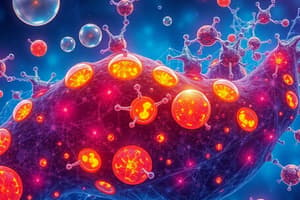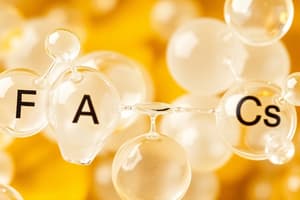Podcast
Questions and Answers
What is the total number of Acetyl CoA units produced from the complete oxidation of palmitic acid?
What is the total number of Acetyl CoA units produced from the complete oxidation of palmitic acid?
- 7 Acetyl CoA
- 9 Acetyl CoA
- 6 Acetyl CoA
- 8 Acetyl CoA (correct)
How many NADH molecules are generated in one complete cycle of β-oxidation for a 16-carbon fatty acid?
How many NADH molecules are generated in one complete cycle of β-oxidation for a 16-carbon fatty acid?
- 6 NADH
- 9 NADH
- 8 NADH
- 7 NADH (correct)
Which of the following statements about odd-numbered fatty acid oxidation is true?
Which of the following statements about odd-numbered fatty acid oxidation is true?
- It generates more NADH compared to even-numbered fatty acids.
- It requires additional energy input compared to even-numbered fatty acids.
- It always results in an even number of Acetyl CoA.
- It produces propionyl CoA, which is converted to succinyl CoA. (correct)
What are the main starting materials for fatty acid synthesis?
What are the main starting materials for fatty acid synthesis?
In the oxidation of margaric acid (17:0), how many total ATP are generated?
In the oxidation of margaric acid (17:0), how many total ATP are generated?
What property characterizes lipids?
What property characterizes lipids?
Which of the following is NOT a role of lipids?
Which of the following is NOT a role of lipids?
What type of lipid is composed of a glycerol backbone and fatty acids?
What type of lipid is composed of a glycerol backbone and fatty acids?
Which structure is characteristic of fatty acids?
Which structure is characteristic of fatty acids?
What is a key component of membrane structure in cells?
What is a key component of membrane structure in cells?
Which of the following lipids is typically involved in thermal insulation?
Which of the following lipids is typically involved in thermal insulation?
What distinguishes sphingolipids from other types of lipids?
What distinguishes sphingolipids from other types of lipids?
What type of lipid is primarily involved in signaling and hormonal functions?
What type of lipid is primarily involved in signaling and hormonal functions?
Which enzyme initiates lipid digestion in the mouth?
Which enzyme initiates lipid digestion in the mouth?
What is the primary function of bile salts in lipid digestion?
What is the primary function of bile salts in lipid digestion?
What is formed in the intestinal cells after the digestion of lipids?
What is formed in the intestinal cells after the digestion of lipids?
How are lipoproteins characterized in terms of structure?
How are lipoproteins characterized in terms of structure?
What type of fatty acid is converted to Acetyl-CoA during catabolism?
What type of fatty acid is converted to Acetyl-CoA during catabolism?
Which product results from the digestion of phospholipids?
Which product results from the digestion of phospholipids?
What role does carnitine play in fatty acid oxidation?
What role does carnitine play in fatty acid oxidation?
Which vitamin is not classified as fat-soluble?
Which vitamin is not classified as fat-soluble?
Flashcards
What are lipids?
What are lipids?
Organic molecules that are insoluble in water but soluble in organic solvents.
What is a fatty acid?
What is a fatty acid?
A long chain of hydrocarbons with a carboxyl group at one end.
What is glycerol?
What is glycerol?
A three-carbon alcohol that serves as the backbone for triacylglycerols.
What is a triacylglycerol?
What is a triacylglycerol?
Signup and view all the flashcards
What are phospholipids?
What are phospholipids?
Signup and view all the flashcards
What are steroids?
What are steroids?
Signup and view all the flashcards
What are sphingolipids?
What are sphingolipids?
Signup and view all the flashcards
What are the roles of lipids?
What are the roles of lipids?
Signup and view all the flashcards
Fatty Acid Activation
Fatty Acid Activation
Signup and view all the flashcards
β-oxidation
β-oxidation
Signup and view all the flashcards
Acetyl-CoA
Acetyl-CoA
Signup and view all the flashcards
Fatty Acid Synthesis
Fatty Acid Synthesis
Signup and view all the flashcards
Acetyl-CoA Transport
Acetyl-CoA Transport
Signup and view all the flashcards
Sphingophospholipids
Sphingophospholipids
Signup and view all the flashcards
Glycolipids
Glycolipids
Signup and view all the flashcards
Lipoproteins
Lipoproteins
Signup and view all the flashcards
Lipid Catabolism
Lipid Catabolism
Signup and view all the flashcards
Lipid Digestion
Lipid Digestion
Signup and view all the flashcards
Lipid Absorption
Lipid Absorption
Signup and view all the flashcards
Lipid Transport
Lipid Transport
Signup and view all the flashcards
Steroids
Steroids
Signup and view all the flashcards
Study Notes
Introduction to Lipids
- Lipids are water-insoluble (hydrophobic) molecules that dissolve in organic solvents
- Lipids have crucial roles in energy storage, membrane structure, and signaling.
Learning Objectives
- Explain structural properties of lipids
- Explain the roles of lipids
- Classify different types of lipids
- Recognize fatty acids
- Explain lipid digestion and absorption
- Identify steroids
- Classify lipoproteins
- Explain fatty acid catabolism (beta oxidation)
- Explain fatty acid synthesis
Types of Lipids
- Fatty acids
- Waxes
- Sphingolipids
- Phospholipids
- Steroids
- Triacylglycerides
- Eicosanoids
- Terpenes
- Ceramides
Lipid Classification
- Storage lipids (neutral): Triacylglycerols
- Membrane lipids (polar): Phospholipids, glycolipids, sphingolipids. Further subdivisions based on backbone (glycerol or sphingosine) and head groups (e.g., phosphoglycerides, sphingomyelins)
Roles of Lipids
- Energy storage (needs less water than carbohydrates)
- Membrane components
- Signaling molecules (hormones)
- Thermal insulation
Fatty Acids
- Basic building blocks of many lipids.
- Consist of a hydrocarbon chain with a carboxyl group at one end.
- Can be saturated (no double bonds) or unsaturated (one or more double bonds).
- Saturated fats are typically solid at room temperature, while unsaturated fats are liquid.
- Differ in structure (saturated vs unsaturated) and in the position of double bonds (omega-3 or omega-6)
Triacylglycerols (TAGs)
- Commonly called triglycerides
- Major energy storage form in adipose tissue
- Composed of three fatty acids linked to a glycerol molecule
- Highly efficient for energy storage due to nonpolar nature
Phospholipids
- Key components of cell membranes
- Composed of a glycerol backbone, two fatty acids and a phosphate group.
- Contain polar hydrophilic head groups, nonpolar hydrophobic tails.
Glycolipids
- Lipids with carbohydrate groups attached
- Important in cell recognition
- Found in cell membranes
- Backbone of glycerol or sphingosine
- Blood type antigens are examples of glycolipids
Steroids
- Diverse group with four fused hydrocarbon rings
- Include hormones (e.g., estrogen, testosterone), cholesterol, and bile acids
- Important role in cellular processes
Lipid Digestion
- Mouth (initial stages)
- Stomach (gastric lipase)
- Small intestine (emulsification by bile salts, pancreatic lipase)
Lipid Absorption
- Micelles are formed for better absorption from the small intestine.
- Fatty acids and monoglycerides pass directly through the intestinal cells
- Fat-soluble vitamins (A, D, E, K) are also absorbed.
- Bile salts are mostly excreted
Lipoproteins
- Used to transport lipids
- Spherical particles with a core of hydrophobic lipids and a coat of phospholipids and proteins.
- Different types (chylomicrons, VLDL, LDL, HDL). Different density and sizes.
- Vary in their lipid composition and functions in the body
Lipid Catabolism (Fatty Acid Oxidation)
- Fatty acids are broken down to produce energy
- CoA is added to fatty acids
- Transport to mitochondria
- Beta oxidation removes 2-carbon units, generating acetyl CoA, NADH, and FADH2
Lipid Anabolism (Fatty Acid Synthesis)
- Synthesis of fatty acids from acetyl CoA using NADPH as reducing agent
- Major Steps: Activation of acetyl-CoA, malonyl CoA synthesis, and elongation reactions.
- Uses NADPH and ATP for energy and building blocks
Studying That Suits You
Use AI to generate personalized quizzes and flashcards to suit your learning preferences.




